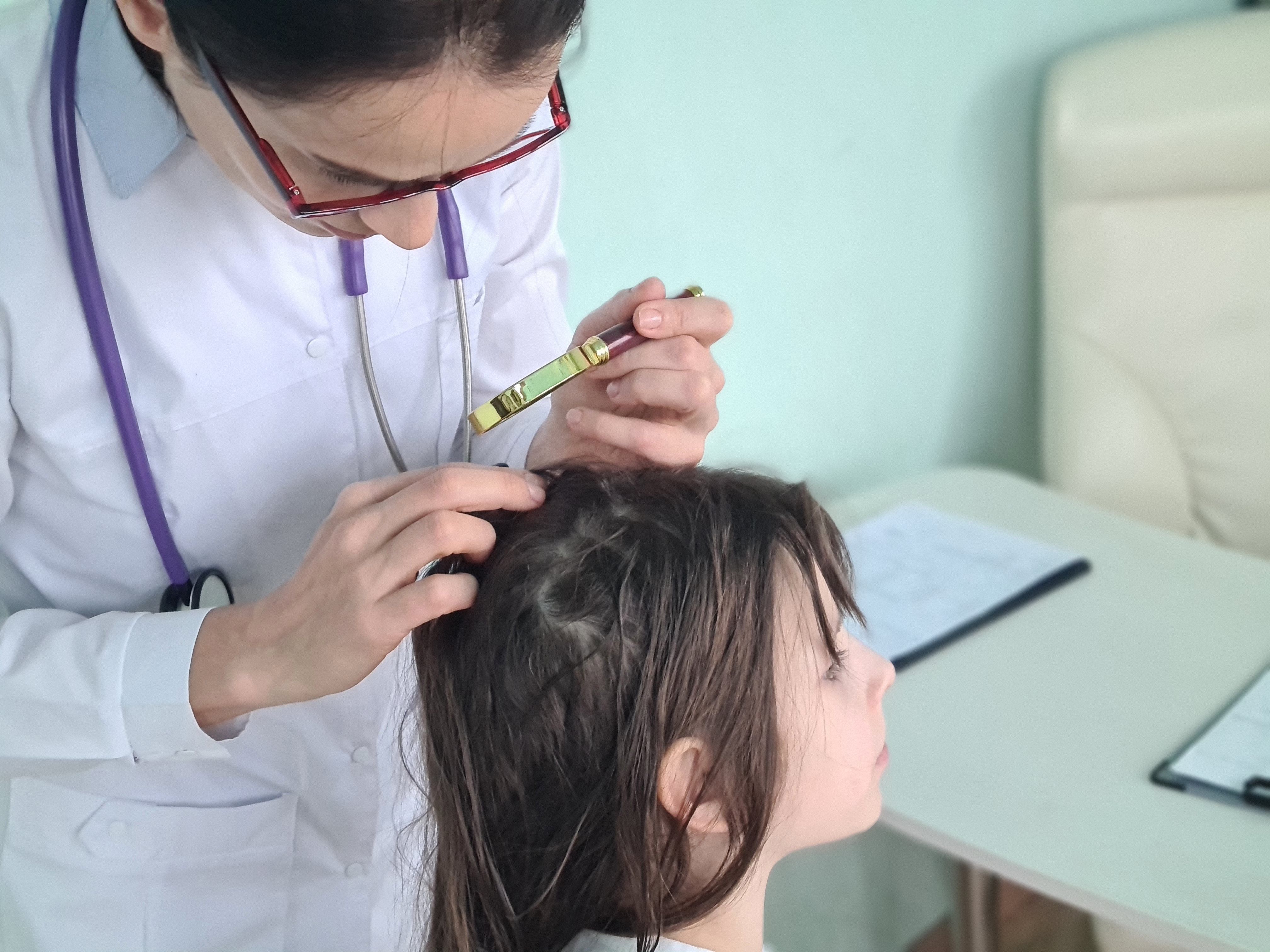- Center on Health Equity & Access
- Clinical
- Health Care Cost
- Health Care Delivery
- Insurance
- Policy
- Technology
- Value-Based Care
Combination Therapies Optimize Hair Regrowth in Pediatric Patients With AA
Corticosteroids are the most common treatment for pediatric patients with alopecia areata (AA), but promising newer options like JAK inhibitors are emerging. This review highlights the importance of personalized treatment plans and maximizing response through combination therapies.
Doctor examines child scalp. | Image Credit: Nadzeya - stock.adobe.com

While corticosteroids, methotrexate, and minoxidil have shown efficacy in treating pediatric patients with alopecia areata (AA), a significant portion of patients benefit from combination therapies to achieve optimal hair regrowth.
Currently, children and adolescents with AA are only offered the FDA-approved drug, ritlecitinib, as a form of treatment. A review conducted research on pediatric and adolescent patients with AA to determine if topical, injectable, or oral treatment options were the most beneficial.
Corticosteroids were the first-line treatment for pediatric patients with AA because they impeded the immune response and follicular damage by terminating the active phase of AA, ultimately allowing a normal hair regrowth cycle. Corticosteroids, administered orally or injected directly into lesions (intralesional), are common first-line treatments. However, due to potential adverse effects, high doses are typically pulsed, often requiring combination therapy, or continued low-dose regimens to manage regrowth and high relapse rates.
Intralesional triamcinolone acetonide offers a higher concentration of the corticosteroid as a perifollicular injection. If topical steroids fail to work, intralesional triamcinolone acetonide is offered to patients capable of tolerating injections.
Minoxidil is another popular treatment for pediatric and adolescent patients with AA because it is possible to apply it in combination with other topical or systemic therapies. Typically, patients are prescribed 2%-5% minoxidil. Methotrexate is frequently used alongside steroids for improved outcomes, while oral minoxidil is gaining popularity for its effectiveness.
Sometimes, Janus kinase (JAK) inhibitors are suggested when topical and intralesional corticosteroids neglect to express the desired clinical response. For severe AA, JAK inhibitors like baricitinib, tofacitinib, and the recently approved ritlecitinib target specific immune pathways to promote hair growth.
Interleukin inhibitors like dupilumab, primarily used for atopic dermatitis, show promise in managing both conditions when combined. However, medications like ustekinumab, anti-IFN-g, phosphodiesterase inhibitors, calcineurin inhibitors (excluding tacrolimus), sulfasalazine, hydroxychloroquine, and photochemotherapy are less common in AA treatment due to limited efficacy or insufficient evidence.
Finally, intravenous immunoglobulin and psychoimmunotherapy suggest potential benefits for specific patients, highlighting the need for a personalized approach to maximize treatment success.
Several uncommon treatment options exist for AA, beyond traditional medications. Platelet-rich plasma (PRP) injections, containing growth factors and cytokines, aim to prevent cell death and promote hair growth. Sildenafil, a phosphodiesterase type 5 (PDE5) inhibitor, can also stimulate hair regrowth. Bimatoprost, a prostaglandin analog, while useful for eyelash regrowth, is not suitable for patients with AA or those undergoing chemotherapy. Squaric acid dibutylester (SADBE) and diphencyprone are offered in specialized clinics due to their potential for allergic reactions in both patients and health care providers.
Anthralin, used more when the medication was easier to access, inhibits cell proliferation but has decreased in popularity. Imiquimod, typically used for skin cancer, and topical bexarotene gel, used for psoriasis, can also be used for AA, but both are uncommon approaches. Finally, studies have explored the use of 308-nm excimer lasers and botulinum toxin injections for pediatric AA, but these remain uncommon treatment options.
For extensive or treatment-resistant AA, combining medications is a common strategy. Methotrexate with corticosteroids is a frequent choice for patients who can't take oral JAK inhibitors. Additionally, some studies show promise for combining mesalamine, a COX inhibitor, with corticosteroids or minoxidil. Anthralin, when used alongside corticosteroids, has also shown potential for hair regrowth, though only in treated areas. Leflunomide combined with anthralin has also been explored with some success.
While trichloroacetic acid (TCA) appears superior to phenol for scalp irritation, zinc's effectiveness alongside PUVA treatment remains unclear. Notably, laser therapy has shown promise with no reported relapses after a year. Research continues, with ongoing clinical trials focusing on JAK inhibitors for children with AA, often exploring combinations of topical, intralesional, and systemic treatments.
Limited FDA-approved treatments exist for pediatric patients with AA. While corticosteroids are common, newer options like JAK inhibitors show promise but come at a higher cost.
The authors concluded, “Earlier access to effective treatment is thought to be important as response may wane the longer patients go without hair regrowth.”
Reference
Westerkam LL, McShane DB, Nieman EL, Morrell DS. Treatment options for alopecia areata in children and adolescents. Pediatric Drugs. Published online March 11, 2024. doi:10.1007/s40272-024-00620-2
The Breakdown: Breast Cancer Research Awareness Day
August 19th 2025Breast cancer is the second most common cancer among women and the second leading cause of cancer-related deaths among women in the US. In light of Breast Cancer Research Awareness Day, The American Journal of Managed Care® breaks down the most recent advancements in breast cancer prevention, screening, and therapies.
Listen
